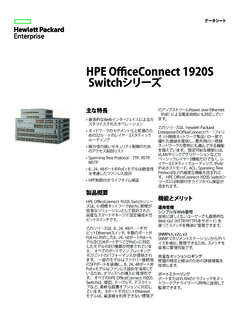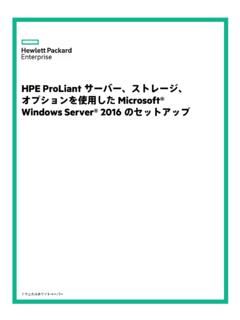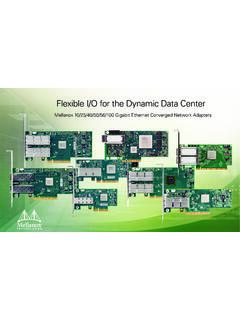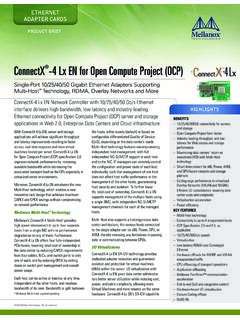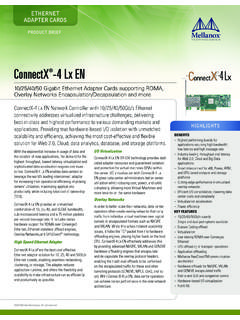Transcription of Configuring and tuning HPE ProLiant Servers for low ...
1 Configuring and tuning HPE ProLiant Servers for low-latency applications Technical white paper Part Number: 581608-009 October 2017 Edition: 10 Technical white paper Contents 3 What s new .. 3 Recommended hardware configurations .. 4 Preparing for low-latency configuration .. 6 Taking inventories or snapshots .. 6 Upgrading BIOS and firmware .. 6 Obtaining the Scripting Utilities .. 8 Recommended platform tuning .. 9 System requirements .. 9 tuning recommendations and explanations .. 9 tuning with HPE iLO RESTFUL Interface Tool (Gen9 and Gen10).
2 16 Recommended operating system tuning .. 20 20 23 HPE-TimeTest .. 24 Frequently asked questions .. 25 Support and other resources .. 26 Resources and documentation .. 26 Before you contact HPE .. 26 HPE contact information .. 27 Acronyms and abbreviations .. 28 Technical white paper Page 3 Introduction Low-latency, deterministic system performance is a required system characteristic in the financial services market, where it enables high frequency trading, market data distribution, and exchange data processing. It is also required in other industries such as real-time signal and image processing.
3 These systems must respond rapidly to external events in a predictable manner. They must do so under heavy workloads, sometimes reaching millions of transactions per second. To achieve this level of performance, system designers must consider the following factors during system design and configuration: Hardware System design, processor type and speed; memory latency, speed, and capacity; network components; and storage subsystem, including SSDs OS selection Operating system kernels specifically designed and tuned for minimum latency and, in some cases, real-time preemption BIOS configuration BIOS support configured for minimum latency and maximum performance Networking fabric Network technology (1/10/25/40 Gigabit Ethernet, InfiniBand, Fibre Channel) Middleware Messaging and database services on the network designed for minimum latency and maximum throughput with reliability.
4 Networking drivers that use transparent kernel bypass libraries, such as VMA for Mellanox connectx - 4 lx and OpenOnload forSolarflare Flareon Ultra SFN8522-PLUS. End-user applications Designed to perform multicast messaging accelerated via kernel bypass and RDMA techniques Physical distances Physical separation between the information sources and clients affects overall system performance. This document presents suggestions and best practice recommendations on BIOS configuration and on basic Linux OS tuning to obtain the lowest-latency performance from HPE ProLiant BL c-Class server blades, HPE Synergy Compute modules, and HPE ProLiant DL, ML, and XL Servers .
5 While this document contains information pertaining to Gen9 and earlier ProLiant Servers , the primary focus is Gen10 Servers . The recommendations to disable System Management Interrupts (SMIs) are intended only for extreme latency-sensitive use cases. Most customers benefit from the power savings, monitoring, and notifications that the SMIs enable. These SMIs consume less than of the server's processing capability, and HPE continues to reduce their impact with each new generation of ProLiant Servers ; in Gen10 Servers , the periodic SMIs have been drastically reduced.
6 Important The information in this document is accurate as of the document s release date but is subject to change based on updates made by HPE. What s new The current edition of the Configuring and tuning HPE ProLiant Servers for Low-Latency Applications White Paper, includes the following additions and updates: Recommended hardware configurations on page 4 o Updated information to new Intel Xeon Scalable versions of processors available on Gen10 Servers o Updated recommended memory speed to 2666 MT/s Updated the following tuning procedures: o Updated BIOS tuning section to discuss Intelligent System tuning functionality (Workload profiles, Jitter Smoothing, Core Boosting) available on Gen10 Servers on page 11 o tuning with HPE iLO RESTful API Interface Tool (Gen9 and Gen10) on page 16 o tuning with CONREP (Gen8 and older) on page 17 o Recommended operating system tuning on page 20 Technical white paper Page 4 Recommended hardware configurations HPE recommends the following HPE ProLiant Gen10 hardware configuration when low-latency is required.
7 This information is subject to change and is valid as of the date of publication. For the latest information, see the server QuickSpecs on the HPE website ( ). The Trade and Match Solution is optimized for applications that perform better at high frequency with lower core count. The latest version is based on Gen10 server technology and provides up to the performance of the Gen9 version of the Trade and Match Solution. The base server configuration contains: o HPE ProLiant DL380 Gen10 or Apollo 6000 Gen10 server o Unique high frequency 8-core processors o Enterprise-grade solution including ECC memory and enterprise level components Processor o Intel Xeon Gold 5122 (4c GHz), Gold 6144 (8c GHz), Gold 6146 (12c GHz), Gold 6142 (16c GHz), and Gold 6154 (18c GHz) in HPE ProLiant DL, ML, and BL Servers , HPE Synergy compute modules, and Apollo System Servers .
8 Note: Not all server models support all processor options. See the server's Quickspecs ( ) for the list of its supported processors. Consider a single processor configuration if your workload does not benefit from a second processor. The benefits of using a single processor are as follows: Yields automatic PCI-to-core affinity (no application rewrite). DDIO performs optimally. Cache snooping is eliminated. No UPI latency is experienced. Simplified CPU core mapping is achieved. Memory o 8 GB single Rank DDR4-2666MT/s CAS-19 RDIMMs for two DIMMs per channel configurations.
9 O If installing only one DIMM per channel, consider using 12 Dual-Rank 2666MT/s 16 GB RDIMMs for improved memory interleaving. o Each channel should be populated with at least one DIMM. PCIe Gen3 architecture o The HPE ProLiant DL380 Gen10 Server offers two x8 slots and one x16 that communicate with each processor. An optional tertiary riser board supports two additional x8 slots. Two additional option slots communicate with processor 1, one x8 FlexibleLOM slot for network options and an x8 Flexible SA slot for storage controller options. o The HPE ProLiant DL360 Gen10 Server offers two x8 or higher slots that communicate with processor 1 and one x16 slot that communicates with processor 2.
10 Two additional option slots communicate with processor 1, one x8 FlexibleLOM slot for network options and an x8 Flexible SA slot for storage controller options. o The HPE ProLiant BL460c Gen10 Server Blade has one x16 mezzanine slot that communicates with processor 1 and one x16 mezzanine that communicates with processor 2, plus a FlexibleLOM off processor 1. o The HPE ProLiant XL230k Gen10 offers up to three optional PCIe expansion slots: one x8 internal, one x16 external, and one x8/x8 internal/external. PCIe NIC o Mellanox connectx - 4 lx -based adapters offer ultra-low latency and are designed specifically for HPE Servers in two form factors: PCIe card (640 SFP28) and FlexibleLOM (640 FLR-SFP28).



